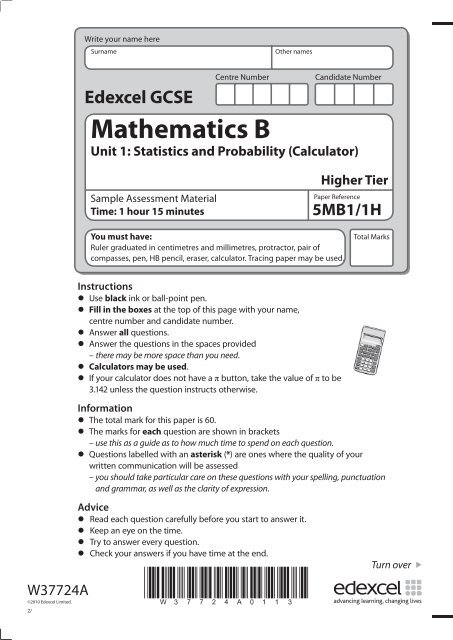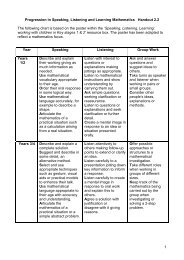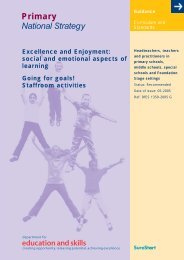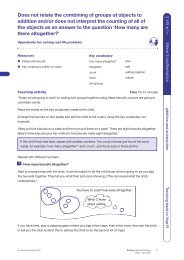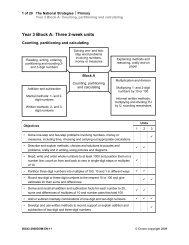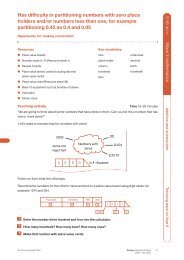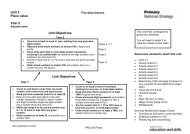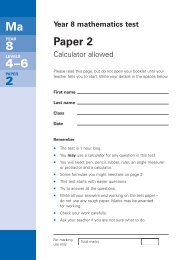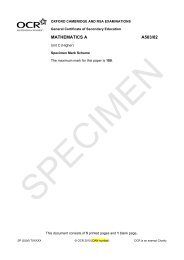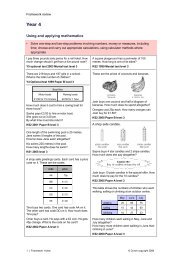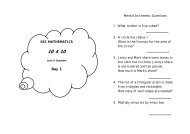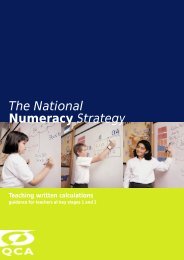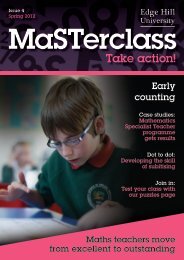Edexcel GCSE Mathematics B Unit 1
Edexcel GCSE Mathematics B Unit 1
Edexcel GCSE Mathematics B Unit 1
Create successful ePaper yourself
Turn your PDF publications into a flip-book with our unique Google optimized e-Paper software.
Write your name here<br />
Surname<br />
Other names<br />
<strong>Edexcel</strong> <strong>GCSE</strong><br />
Centre Number<br />
Candidate Number<br />
<strong>Mathematics</strong> B<br />
<strong>Unit</strong> 1: Statistics and Probability (Calculator)<br />
Sample Assessment Material<br />
Time: 1 hour 15 minutes<br />
Higher Tier<br />
Paper Reference<br />
5MB1/1H<br />
You must have:<br />
Ruler graduated in centimetres and millimetres, protractor, pair of<br />
compasses, pen, HB pencil, eraser, calculator. Tracing paper may be used.<br />
Total Marks<br />
W37724A<br />
©2010 <strong>Edexcel</strong> Limited.<br />
2/<br />
Instructions<br />
Use black ink or ball-point pen.<br />
• Fill in the boxes at the top of this page with your name,<br />
centre number and candidate number.<br />
Answer all questions.<br />
• Answer the questions in the spaces provided<br />
– there may be more space than you need.<br />
Calculators may be used.<br />
• If your calculator does not have a π button, take the value of π to be<br />
3.142 unless the question instructs otherwise.<br />
Information<br />
The total mark for this paper is 60.<br />
• The marks for each question are shown in brackets<br />
– use this as a guide as to how much time to spend on each question.<br />
• Questions labelled with an asterisk (*) are ones where the quality of your<br />
written communication will be assessed<br />
– you should take particular care on these questions with your spelling, punctuation<br />
and grammar, as well as the clarity of expression.<br />
Advice<br />
Read each question carefully before you start to answer it.<br />
Keep an eye on the time.<br />
Try to answer every question.<br />
• Check your answers if you have time at the end.<br />
*W37724A0113*<br />
Turn over
EDEXCEL<br />
<strong>GCSE</strong> <strong>Mathematics</strong><br />
Formulae Sheet – Higher Tier<br />
Area of trapezium = 21<br />
(a + b)h<br />
Volume of prism = area of cross-section × length<br />
Volume of sphere = 34<br />
π r 3<br />
Surface area of sphere = 4π r 2<br />
Volume of cone = 31<br />
π r 2 h<br />
Curved surface area of cone = π rl<br />
In any triangle ABC<br />
C<br />
b<br />
a<br />
A<br />
c<br />
B<br />
Sine Rule:<br />
a<br />
sin A<br />
=<br />
b<br />
sin B<br />
=<br />
c<br />
sin C<br />
Cosine Rule:<br />
a 2 = b 2 + c 2 –2bc cos A<br />
Area of a triangle<br />
= 2<br />
1 ab sin C<br />
The Quadratic Equation<br />
The solutions of ax 2 + bx + c = 0, where a ≠ 0, are given by x =<br />
− b ±<br />
( b<br />
2 − 4ac)<br />
2a
Answer ALL questions.<br />
Write your answers in the spaces provided.<br />
You must write down all stages in your working.<br />
1. The table shows some information about the ages, in years, of 80 people.<br />
Age (a years)<br />
Frequency<br />
20 ≤ a < 30 19<br />
30 ≤ a < 40 22<br />
40 ≤ a < 50 24<br />
50 ≤ a < 60 10<br />
60 ≤ a < 70 5<br />
(a)<br />
(b)<br />
Find the class interval that contains the median.<br />
Draw a frequency polygon to show this information.<br />
(1)<br />
...........................................<br />
(2)<br />
Frequency<br />
30<br />
20<br />
10<br />
0<br />
20 30 40 50 60 70<br />
Age (a years)<br />
(Total for Question 1 = 3 marks)<br />
1
*2. Harry and Edith are planning their holiday.<br />
They want to travel by airplane.<br />
They can travel with one of three airplane companies, Aireways, King Lingus or Easy Plane.<br />
The tables show the cost per adult and the cost per child to travel with each airplane<br />
company.<br />
Aireways<br />
July<br />
August<br />
Week 1 - 8 9 - 15 16 - 22 23 - 31 1 - 12 13 - 19 20 - 26 27 - 31<br />
Adult AM £197 £200 £215 £215 £224 £209 £199 £188<br />
PM £174 £177 £192 £192 £201 £186 £176 £165<br />
Child AM £110 £113 £128 £128 £137 £122 £112 £101<br />
PM £87 £90 £105 £105 £114 £99 £89 £78<br />
King Lingus<br />
Easy Plane<br />
July<br />
August<br />
Week 1 - 8 9 - 15 16 - 22 23 - 31 1 - 12 13 - 19 20 - 26 27 - 31<br />
Adult AM £193 £195 £197 £211 £220 £213 £208 £204<br />
PM £176 £178 £180 £191 £203 £196 £191 £187<br />
Child AM £119 £121 £123 £134 £146 £139 £134 £130<br />
PM £102 £104 £106 £117 £129 £122 £117 £113<br />
July<br />
August<br />
Week 1 - 8 9 - 15 16 - 22 23 - 31 1 - 12 13 - 19 20 - 26 27 - 31<br />
Adult AM £198 £206 £213 £223 £232 £214 £210 £205<br />
PM £181 £189 £196 £206 £215 £197 £193 £188<br />
Child AM £94 £102 £109 £119 £128 £110 £106 £101<br />
PM £77 £85 £92 £102 £111 £93 £89 £84<br />
Harry and Edith have 3 children.<br />
They want to travel on the morning of 27th July.<br />
Work out the cheapest cost.<br />
..................................................<br />
(Total for Question 2 = 6 marks)<br />
(In a live paper this question would be set out over two pages to allow space for candidate’s working.)<br />
2
*3. Some students did a test.<br />
This back-to-back stem and leaf diagram shows information about their scores.<br />
Boys' scores<br />
Girls' scores<br />
8 2 2 7 8<br />
9 6 5 2 3 0 4 7 8<br />
9 5 4 3 2 1 0 4 3 5 5 7 8<br />
7 7 7 6 5 4 5<br />
0 1 3 5 7 7 7 9<br />
9<br />
5 3 2 1 6 0 3 6<br />
Key for boys' scores<br />
8 | 2 means 28<br />
Key for girls' scores<br />
2 | 7 means 27<br />
Compare and contrast the scores of these students.<br />
(Total for Question 3 = 6 marks)<br />
3
4. Charles wants to find out how much people spend on sweets.<br />
He will use a questionnaire.<br />
(a) Design a suitable question for Charles to use in his questionnaire.<br />
(2)<br />
Charles asks the people in his class to do his questionnaire.<br />
(b)<br />
Give a reason why this may not be a suitable sample.<br />
...............................................................................................................................................<br />
...............................................................................................................................................<br />
(1)<br />
(Total for Question 4 = 3 marks)<br />
4
5. The scatter graph shows some information about a random sample of ten players at a<br />
basketball club.<br />
For each player it shows his height and his weight.<br />
120<br />
Weight (kg)<br />
110<br />
100<br />
90<br />
80<br />
70<br />
60<br />
180 190 200 210 220<br />
Height (cm)<br />
(a) (i) On the scatter graph, draw a line of best fit.<br />
(ii) Work out the gradient of your line of best fit.<br />
(iii) Write down a practical interpretation of this gradient.<br />
(1)<br />
(2)<br />
...................................<br />
(2)<br />
...............................................................................................................................................<br />
...............................................................................................................................................<br />
5
Some of the players at the basketball club have a weight greater than 99 kg.<br />
(b) Estimate the proportion of these players who have a height less than 200 cm.<br />
(2)<br />
..................................<br />
(Total for Question 5 = 7 marks)<br />
6
*6. Jenny uses her mother's recipe to make cheese scones.<br />
Her recipe uses a mixture of self-raising flour, butter and cheese in the ratio 6 : 2 : 1 by<br />
weight.<br />
In her kitchen, Jenny has<br />
2 kg of self-raising flour<br />
500 grams of butter<br />
2oo grams of cheese<br />
When Jenny makes cheese scones each scone weighs about 45 grams.<br />
Work out the largest number of cheese scones that Jenny can make.<br />
........................................<br />
(Total for Question 6 = 4 marks)<br />
7
7. A bag contains only red counters, blue counters, green counters and yellow counters.<br />
Rachel is going to take at random a counter from the bag.<br />
The table shows each of the probabilities that Rachel will take a red counter or a blue counter<br />
or a green counter or a yellow counter.<br />
Colour Red Blue Green Yellow<br />
Probabilit<br />
y<br />
0.15 2x x 0.1<br />
(a) Work out the probability that Rachel will take a Green counter.<br />
(2)<br />
………..............……………….<br />
Rachel says that there are exactly 9 blue counters in the bag.<br />
Rachel is wrong.<br />
(b) Explain why there cannot be exactly 9 blue counters in the bag.<br />
(1)<br />
...............................................................................................................................................<br />
…...........................................................................................................................................<br />
(Total for Question 7 = 3 marks)<br />
8. A book has 120 pages.<br />
The mean number of words per page for the whole book is 231<br />
The mean number of words per page for the first 20 pages is 236<br />
Calculate the mean number of words per page for the other 100 pages.<br />
...........................................<br />
(Total for Question 8 = 3 marks)<br />
8
*9. Kylie wants to invest £20 000 for 3 years.<br />
She considers two investments, Investment A and Investment B.<br />
Investment A<br />
£20 000<br />
Earns 3.02% interest per annum<br />
Investment B<br />
£20 000<br />
Earns 2.98% compound interest per annum<br />
Interest paid yearly by cheque<br />
Kylie wants to get the greatest return on her investment.<br />
Which of these investments should she choose<br />
...........................................................<br />
(Total for Question 9 = 6 marks)<br />
9
10. The table gives some information about the lengths of time, in hours, that some batteries<br />
lasted.<br />
Time (h hours) Frequency<br />
0 ≤ h
11. (a) Explain what is meant by<br />
(i) a random sample,<br />
(1)<br />
...................................................……………………………………………………………<br />
...................................................……………………………………………………………<br />
(ii) a stratified sample.<br />
(1)<br />
...................................................……………………………………………………………<br />
...................................................……………………………………………………………<br />
A Sixth Form College has 850 students.<br />
The table shows some information about these students.<br />
Number of Number of<br />
female students male students<br />
Year 12 184 241<br />
Year 13 222 203<br />
Linda is going to do a survey of the students in the college.<br />
She uses a sample of 50 students stratified by year group and by gender.<br />
(b)<br />
Work out the number of Year 12 female students in her sample.<br />
(2)<br />
……………....................……<br />
(Total for Question 11 = 4 marks)<br />
11
*12.<br />
Spin the wheel<br />
50p<br />
20p<br />
5p<br />
10p<br />
Bert has a game at a fete.<br />
In the game players pay to spin a wheel.<br />
When the wheel stops, the amount shown by the arrow is given to the player.<br />
The table shows the probabilities that the wheel will stop on 5p, on 10p, on 20p and on 50p.<br />
5p 10p 20p 50p<br />
Probability 0.5 0.25 0.15 0.1<br />
Bert wants to make a profit from the game.<br />
Work out the minimum he can charge players to spin the wheel.<br />
....................................<br />
(Total for Question 12 = 4 marks)<br />
12
13. In a bag there are 5 red counters and 4 blue counters.<br />
Suki takes at random two counters from the bag.<br />
Work out the probability that the counters will each have a different colour.<br />
................................................<br />
(Total for Question 13 = 4 marks)<br />
13
*14.<br />
Angling Chronicle<br />
Anglers dismayed at dwindling fish numbers!<br />
A scientist wants to estimate the number of fish in a lake.<br />
He catches 50 fish from the lake and marks them with a dye.<br />
The fish are then returned to the lake.<br />
The next day the scientist catches another 50 fish.<br />
4 of these fish are marked with the dye.<br />
Work out an estimate for the total number of fish in the lake.<br />
You must write down any assumptions you have made.<br />
....................................................<br />
(Total for Question 14 = 4 marks)<br />
(TOTAL FOR PAPER = 60 MARKS)<br />
14


